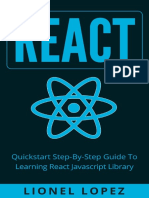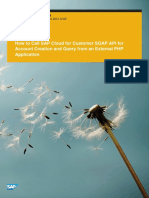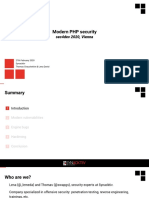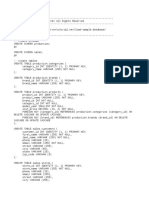PHP FB API
Uploaded by
shambalicPHP FB API
Uploaded by
shambalicFACEBOOK PHP SDK class Facebook
Provides access to the Facebook Platform.
Version 2.0.3 ‐ 11‐5‐2010
http://github.com/facebook/php‐sdk/ public static $CURL_OPTS public function __construct($config) protected function _restserver($params)
// Array ‐ Default options for curl.
Default options for curl. // Initialize a Facebook Application.
pp // Invoke the old restserver.php endpoint.
p p p
public static $DOMAIN_MAP public function setAppId($appId) protected function _graph($path,
// Array ‐ Maps aliases to Facebook domains. // Set the Application ID. $method='GET', $params=array())
class FacebookApiException public function getAppId()
// Invoke the Graph API.
protected static $DROP_QUERY_PARAMS // Get the API Key.
Thrown when an API call returns an exception. // Array ‐ List of query parameters that get automatically dropped protected function _oauthRequest($url,
// when rebuilding the current URL.
public function setApiSecret($apiSecret)
$params)
// Make a OAuth Request
// Set the API Secret.
t t d $appId;
protected
// The Application ID. protected function makeRequest($url, $params,
protected $result; public function getApiSecret()
// The result from the API server that represents the exception
// Get the API Secret. $ch=null)
// information.
protected $apiSecret; // Makes an HTTP request. This method can be overriden by
// The Application API Secret. public function // subclasses if developers want to do fancier things or use
// something other than curl to make the request.
setCookieSupport($cookieSupport)
public function __construct($result) protected $session; // Set the Cookie Support status.
// Make a new API Exception with the given result. // The active user session, if one is available.
protected function getSessionCookieName()
// The name of the Cookie that contains the session.
public function useCookieSupport()
public function getResult()
l () protected $sessionLoaded
$ i L d d = false;
f l // Get the Cookie Support status.
protected function
// Return the associated result object returned by the API server. // Indicates that we already loaded the session as best as we could.
public function setBaseDomain($domain)
setCookieFromSession($session=null)
// Set a JS Cookie based on the _passed in_ session. It does not use
public function getType() protected $cookieSupport = false; // Set the base domain for the Cookie.
// the currently stored session ‐‐ you need to explicitly pass it in.
// Returns the associated type for the error. This will default to // Indicates if Cookie support should be enabled.
// 'Exception' when a type is not available. public function getBaseDomain() protected function
// Get the base domain for the Cookie.
protected $baseDomain = ''; validateSessionObject($session)
// Base domain for the Cookie. // Validates a session_version=3 style session object.
public function __toString() public function setSession($session=null, ,
// To make debugging easier
// To make debugging easier.
$ i
$write_cookie=true)
ki ) protected function getApiUrl($method)
// Set the Session. // Build the URL for api given parameters.
public function getSession() protected function getUrl($name, $path='',
// Get the session object. This will automatically look for a signed
example.php // session sent via the Cookie or Query Parameters if needed. $params=array())
<?php <!doctype html> appId : '<?php echo $facebook‐>getAppId(); ?>', button></fb:login‐button> // Build the URL for given domain alias, path and parameters.
require '../src/facebook.php'; <html status : true, // check login status </div>
xmlns:fb="http://www.facebook.com/2008/fbml"> cookie : true, // enable cookies to allow the server to <div> public function getUser()
// Create our Application instance.
$facebook = new Facebook(array(
<head>
<title>php‐sdk</title>
access the session
xfbml : true // parse XFBML
Without using JavaScript & XFBML:
<a href="<?php echo $loginUrl; ?>"> // Get the UID from the session. protected function getCurrentUrl()
'appId'
appId => '254752073152',
254752073152 , }); <img
img // Returns the Current URL, stripping it of known FB parameters that
// Returns the Current URL, stripping it of known FB parameters that
'secret' => '904270b68a2cc3d54485323652da4d14', <style> src="http://static.ak.fbcdn.net/rsrc.php/zB6N8/hash/
// should not persist.
'cookie' => true,
));
body {
font‐family: 'Lucida Grande', Verdana, Arial, sans‐
// whenever the user logs in, we refresh the page
FB.Event.subscribe('auth.login', function() {
4li2k73z.gif">
</a>
public function getLoginUrl($params=array())
serif; window.location.reload(); </div> // Get a Login URL for use with redirects. By default, full page
$me = null; } }); <?php endif ?> protected static function
// Session based API call. h1 a { }; <h3>Session</h3>
// redirect is assumed. If you are using the generated URL with a
if ($session) { text‐decoration: none; <?php if ($me): ?> // window.open() call in JavaScript, you can pass in display=popup as generateSignature($params, $secret)
try { color: #3b5998; (function() { <pre><?php print_r($session); ?></pre>
$uid = $facebook‐>getUser(); } var e = document.createElement('script');
// part of the $params. // Generate a signature for the given params and secret.
$me = $facebook‐>api('/me'); h1 a:hover { e.src = document.location.protocol + <h3>You</h3>
} catch (FacebookApiException $e) { text‐decoration: underline; '//connect.facebook.net/en_US/all.js'; <img src="https://graph.facebook.com/<?php echo
error_log($e); } e.async = true; $uid; ?>/picture"> public function getLogoutUrl($params=array())
} </style> document.getElementById('fb‐root').appendChild(e); <?php echo $me['name']; ?>
} }()); // Get a Logout URL suitable for use with redirects.
</head> </script> <h3>Your User Object</h3>
// login or logout url
// g g will be needed depending on
p g <body> y <pre><?php
p p pp print_r($me); ?></pre>
($ ); /p
current user state. <h1><a href="example.php">php‐sdk</a></h1> <?php else: ?> public function
bl f
if ($me) {
$logoutUrl = $facebook‐>getLogoutUrl();
<!‐‐
We use the JS SDK to provide a richer user <?php if ($me): ?>
<strong><em>You are not
Connected.</em></strong> getLoginStatusUrl($params=array()) Cheat Sheet available at
} else { experience. For more info, <a href="<?php echo $logoutUrl; ?>"> <?php endif ?>
}
$loginUrl = $facebook‐>getLoginUrl(); look here: http://github.com/facebook/connect‐js
‐‐>
<img
src="http://static.ak.fbcdn.net/rsrc.php/z2Y31/hash/ <h3>Naitik</h3>
// Get a login status URL to fetch the status from facebook. www.princessdesign.net
cxrz4k7j.gif"> <img
// This call will always work since we are fetching
public data.
<div id="fb‐root"></div>
<script>
</a>
<?php else: ?>
src="https://graph.facebook.com/naitik/picture">
<?php echo $naitik['name']; ?>
public function api(/* polymorphic */)
$naitik = $facebook‐>api('/naitik'); window.fbAsyncInit = function() { <div> </body> // Make an API call.
?> FB.init({ Using JavaScript & XFBML: <fb:login‐ </html>
You might also like
- The Healing Gods Complementary and Alternative Medicine in Christian America83% (6)The Healing Gods Complementary and Alternative Medicine in Christian America337 pages
- Step by Step To Develop A Facebook Application Using CodeigniterNo ratings yetStep by Step To Develop A Facebook Application Using Codeigniter4 pages
- Facebook Development Using Zend Framework: Brett HarrisNo ratings yetFacebook Development Using Zend Framework: Brett Harris36 pages
- +++ REST API For Legacy PHP Projects - Toptal®No ratings yet+++ REST API For Legacy PHP Projects - Toptal®22 pages
- GET Head Post: Request Has Been Successfully Completed. Responses Are Grouped in Five ClassesNo ratings yetGET Head Post: Request Has Been Successfully Completed. Responses Are Grouped in Five Classes3 pages
- Facebook Mobile Hack Crash Course: Singapore 19th March 2012No ratings yetFacebook Mobile Hack Crash Course: Singapore 19th March 201262 pages
- Middleware - Laravel 12.x - The PHP Framework for Web ArtisansNo ratings yetMiddleware - Laravel 12.x - The PHP Framework for Web Artisans16 pages
- Htmla Gibraltar Server Comparison (Microsoft Design Document)No ratings yetHtmla Gibraltar Server Comparison (Microsoft Design Document)17 pages
- Easy Web Services Using PHP Reflection 1229096730084678 1No ratings yetEasy Web Services Using PHP Reflection 1229096730084678 121 pages
- SSRF Bible. Cheatsheet: @wallarm @d0znppNo ratings yetSSRF Bible. Cheatsheet: @wallarm @d0znpp23 pages
- Facebook For Websites: Documentation Forum Showcase BlogNo ratings yetFacebook For Websites: Documentation Forum Showcase Blog4 pages
- SSRF Bible. Cheatsheet: Try Our New ProductNo ratings yetSSRF Bible. Cheatsheet: Try Our New Product23 pages
- The GET Method Is Not Supported For Route Login. Supported Methods - POSTNo ratings yetThe GET Method Is Not Supported For Route Login. Supported Methods - POST1 page
- Learn How To Design REST API in 9 MinutesNo ratings yetLearn How To Design REST API in 9 Minutes18 pages
- Developing Facebook Application: Wasu Khaodee Kanda Runapongsa Saikaew Computer Engineering Khon Kaen UniversityNo ratings yetDeveloping Facebook Application: Wasu Khaodee Kanda Runapongsa Saikaew Computer Engineering Khon Kaen University20 pages
- Content Server - Web Services - How To Use Search API With REST AuthenticationNo ratings yetContent Server - Web Services - How To Use Search API With REST Authentication7 pages
- Understanding Software Engineering Vol 3: Programming Basic Software Functionalities.From EverandUnderstanding Software Engineering Vol 3: Programming Basic Software Functionalities.No ratings yet
- IGNOU PGDCA MCS 206 Object Oriented Programming using Java Previous Years solved PapersFrom EverandIGNOU PGDCA MCS 206 Object Oriented Programming using Java Previous Years solved PapersNo ratings yet
- Sacred Stories, Spiritual Tribes Finding Religion in Everyday Life PDF100% (1)Sacred Stories, Spiritual Tribes Finding Religion in Everyday Life PDF395 pages
- SAS93 - Software Modeling (UML) : 1 Multiple Choice Questions (5 Points)No ratings yetSAS93 - Software Modeling (UML) : 1 Multiple Choice Questions (5 Points)4 pages
- DSCI - Aldefi - Privacy - Enhancing - Technologies - 1717593430 2024-06-05 13 - 17 - 17No ratings yetDSCI - Aldefi - Privacy - Enhancing - Technologies - 1717593430 2024-06-05 13 - 17 - 1748 pages
- $ Wget - H GNU Wget 1.10.2, A Non-Interactive Network Retriever.100% (2)$ Wget - H GNU Wget 1.10.2, A Non-Interactive Network Retriever.3 pages
- Prasad V.Potluri Siddhartha Institute of Technology, Kanuru, VijayawadaNo ratings yetPrasad V.Potluri Siddhartha Institute of Technology, Kanuru, Vijayawada3 pages
- AWS Certified Solutions Architect Associate Practice Test 5No ratings yetAWS Certified Solutions Architect Associate Practice Test 5158 pages
- Sample Plan For The Plan: Project Initiation ActivitiesNo ratings yetSample Plan For The Plan: Project Initiation Activities2 pages
- Scrum - A Breathtakingly Brief and Agile Introduction Chris Sims, Hillary Louise JohnsonNo ratings yetScrum - A Breathtakingly Brief and Agile Introduction Chris Sims, Hillary Louise Johnson12 pages
- Compiler Design Tutorial For Beginners - Complete GuideNo ratings yetCompiler Design Tutorial For Beginners - Complete Guide3 pages
- How To Play The Undead Blocks Public Beta:: Step 1 - Create An NFT Compatible Crypto WalletNo ratings yetHow To Play The Undead Blocks Public Beta:: Step 1 - Create An NFT Compatible Crypto Wallet13 pages









































































































